Walk in showers have become the centerpiece of modern bathroom design, transforming ordinary spaces into luxurious, spa-like retreats. With over 60% of homeowners choosing to replace at least one bathtub in favor of a walk in shower during renovations, these accessible and stylish fixtures represent one of the most popular upgrades in contemporary bathroom design—especially when considering tub-to-shower conversions or exploring design options that incorporate or replace a tub.
Whether you’re working with a compact space or designing a master bathroom oasis, walk in shower ideas offer endless possibilities for creating a functional and beautiful room. From doorless shower ideas that create seamless, open layouts to budget-friendly solutions that maximize style without breaking the bank, the right shower design can dramatically improve both your daily routine and your home’s resale value.
This comprehensive guide explores over 50 stunning walk in shower ideas, covering everything from tile selections and color schemes to accessibility features and luxury amenities. You’ll discover practical solutions for every space, budget, and style preference, helping you create the perfect shower that meets your unique needs.
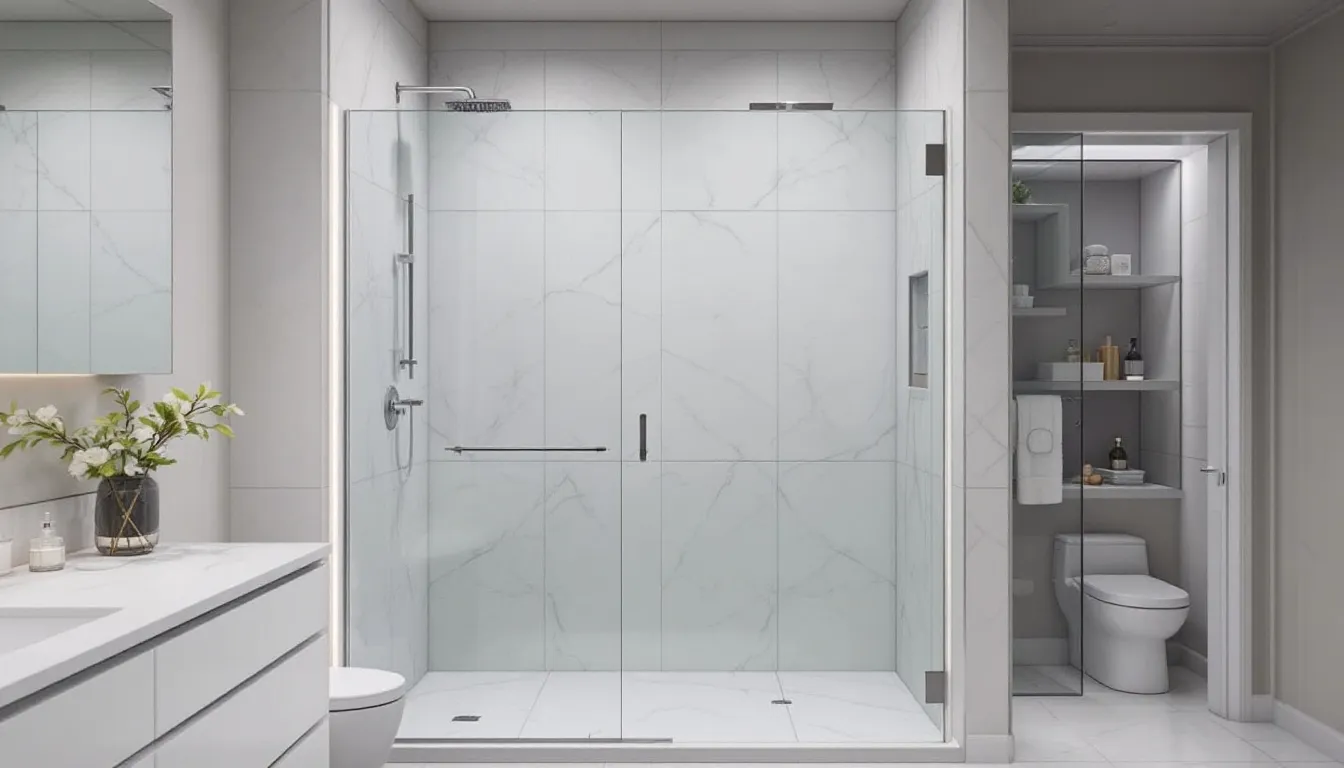
Popular Walk-In Shower Styles
Doorless Walk-In Showers with Fixed Glass Panels
Doorless shower ideas represent the pinnacle of open, spacious bathroom design. These showers eliminate traditional shower doors entirely, using strategically placed fixed glass panels to contain water while maintaining an airy, unenclosed feel. The key to successful doorless designs lies in proper showerhead placement and careful consideration of water spray patterns.
A typical doorless shower requires at least 36 inches of width and benefits from a shower floor that slopes gradually toward a linear drain. This style works particularly well in larger bathrooms where the extra space allows for proper water containment without compromising the rest of the room.
Minimalist Designs with Neutral Color Palettes
Clean lines and neutral tones define minimalist walk in showers, creating serene spaces that feel both timeless and contemporary. White tile remains the most popular choice, often combined with subtle gray accents or natural stone elements. These designs emphasize simplicity through uncluttered surfaces, hidden storage solutions, and streamlined fixtures.
The minimalist approach works especially well in smaller bathrooms, where light colors and simple forms help create the illusion of more space. A monochromatic white tile scheme, for example, can make even a compact shower feel bright and airy.
Choosing the right paint color for bathroom walls or ceilings can further enhance the minimalist style and overall ambiance, complementing your tile choices and adding a subtle finishing touch.
Modern Farmhouse Style with Charcoal Metal Doors and Brass Fixtures
Modern farmhouse style brings warm, rustic charm to walk in shower design through the strategic use of materials and hardware. Charcoal-finished metal doors provide industrial contrast against warm hues like cream subway tiles or natural stone walls. Brass fixtures add warmth and character, creating a perfect balance between contemporary function and traditional aesthetics.
This style often incorporates shiplap-inspired wall treatments, rustic wood vanity elements, and vintage-style accessories to complete the farmhouse look while maintaining modern shower functionality.
Contemporary Glass-Enclosed Showers with Frameless Doors
Contemporary designs emphasize sleek, seamless appearances through the use of frameless glass enclosures. These showers typically feature floor-to-ceiling glass walls that maximize light transmission while creating clean, uninterrupted sight lines throughout the bathroom.
Frameless glass doors swing on heavy-duty hinges, creating a luxurious feel while requiring precise installation for proper sealing and function. The lack of visible frames allows other design elements like beautiful tile work or fixtures to take center stage.
Traditional Alcove Showers with Marble and Classic Fixtures
Traditional alcove showers fit into three-walled spaces, making them ideal for replacing existing bathtub installations. Some traditional alcove designs may also incorporate a soaking tub for added luxury and relaxation. These designs often feature classic materials like Carrara marble subway tiles, traditional chrome fixtures, and decorative elements such as chair rail molding or built-in soap niches with elegant trim work.
The alcove configuration maximizes efficiency in smaller bathrooms while providing opportunities for luxurious material selections that create an upscale appearance within a compact footprint.
Wet Room Designs for Seamless Integration
Wet room designs eliminate traditional shower enclosures entirely, creating fully waterproofed bathroom spaces where the shower area blends seamlessly with the rest of the room. The entire bathroom floor slopes toward a central or linear drain, allowing water to flow away from all areas.
This European-inspired approach works particularly well in smaller bathrooms where traditional shower enclosures might feel cramped. Wet rooms require extensive waterproofing but create an incredibly spacious feeling even in limited square foot areas.
Tile Ideas for Walk-In Showers
Subway Tile Installations from Floor to Ceiling
Subway tiles remain one of the most versatile and popular choices for walk in showers. The classic 3-by-6-inch format can be installed in traditional brick patterns, vertical stacks, or herringbone arrangements to create different visual effects. Floor-to-ceiling installations create continuity and make shower walls appear taller.
White tile subway installations provide a timeless backdrop that works with any fixtures or accessories, while colored variations in soft blues, greens, or grays add personality without overwhelming the space. The key to successful subway tile design lies in selecting the right grout color and pattern orientation for your specific goals.
Hexagon Marble Tiles for Geometric Patterns
Hexagon tiles create stunning geometric patterns that add visual interest to shower walls and floors. Marble hexagons in classic white Carrara or dramatic black varieties provide sophisticated texture while maintaining timeless appeal. The six-sided shape allows for creative layout possibilities, from uniform patterns to mixed-size installations that create dynamic focal points.
When using hexagon tiles on both walls and floors, varying the size between 2-inch floor tiles and 4-inch wall tiles creates subtle visual hierarchy while maintaining pattern continuity throughout the shower space.
Zellige Tiles for Handcrafted Texture
Zellige tiles bring artisanal character to walk in showers through their irregular, handmade surfaces and rich color variations. These Moroccan-inspired tiles work particularly well in designs that emphasize texture and warmth. Popular colors include robin’s egg blue for spa-like serenity and earthy terracotta tones that add warmth to neutral color schemes.
The slightly uneven surface of zellige tiles creates beautiful light play throughout the day, making each shower experience feel unique. These tiles pair beautifully with brass fixtures and natural stone accents.
Mosaic Tile Borders and Accent Walls
Mosaic tiles allow for incredible creativity in walk in shower design, from delicate floral patterns to bold geometric borders. Small-scale mosaics work well as accent elements, creating visual interest without overwhelming the space. A mosaic tile border at eye level, for example, can add sophistication to an otherwise simple subway tile installation. Using mosaic tiles on the back wall of a walk-in shower can create a dramatic focal point and enhance the overall design.
Natural stone mosaics in tumbled marble or travertine create spa-like atmospheres, while glass mosaics reflect light beautifully and work well in contemporary designs. The key is using mosaics strategically as accent elements rather than covering entire walls.
Pebble Stone Tiles for Natural Flooring
Natural stone pebble tiles create spa-like shower floors with excellent slip resistance and organic beauty. These tiles, typically mounted on mesh backing for easy installation, provide natural massage benefits underfoot while creating visual connection to outdoor elements.
River rock pebbles in neutral gray and beige tones work well with any color scheme, while more dramatic options like black pebbles create striking contrast against light-colored walls. The natural variation in stone sizes and colors ensures that no two installations look exactly alike.
Large Format Porcelain for Seamless Appearance
Large format tiles, typically 12 inches or larger, create seamless appearances with minimal grout lines. These tiles are available in stunning porcelain versions that perfectly mimic natural marble, limestone, or wood without the maintenance requirements of natural materials.
A tiled shower using large format tiles can achieve a seamless, high-end appearance, offering a luxurious and customizable option for bathroom renovations.
The reduced number of grout lines makes cleaning easier while creating sophisticated, uninterrupted surfaces that feel luxurious and modern. Large format tiles work particularly well on back walls where their scale can be fully appreciated.
Mixed Tile Combinations for Visual Interest
Combining different tile sizes, textures, and materials creates sophisticated layered designs that add personality to walk in showers. A popular approach combines large format wall tiles with smaller mosaic accents, or mixes subway tiles with hexagon patterns for geometric interest.
When mixing tiles, maintaining a consistent color palette ensures cohesion while allowing different textures and scales to create visual depth. Limiting combinations to two or three different tiles prevents the design from becoming overwhelming.
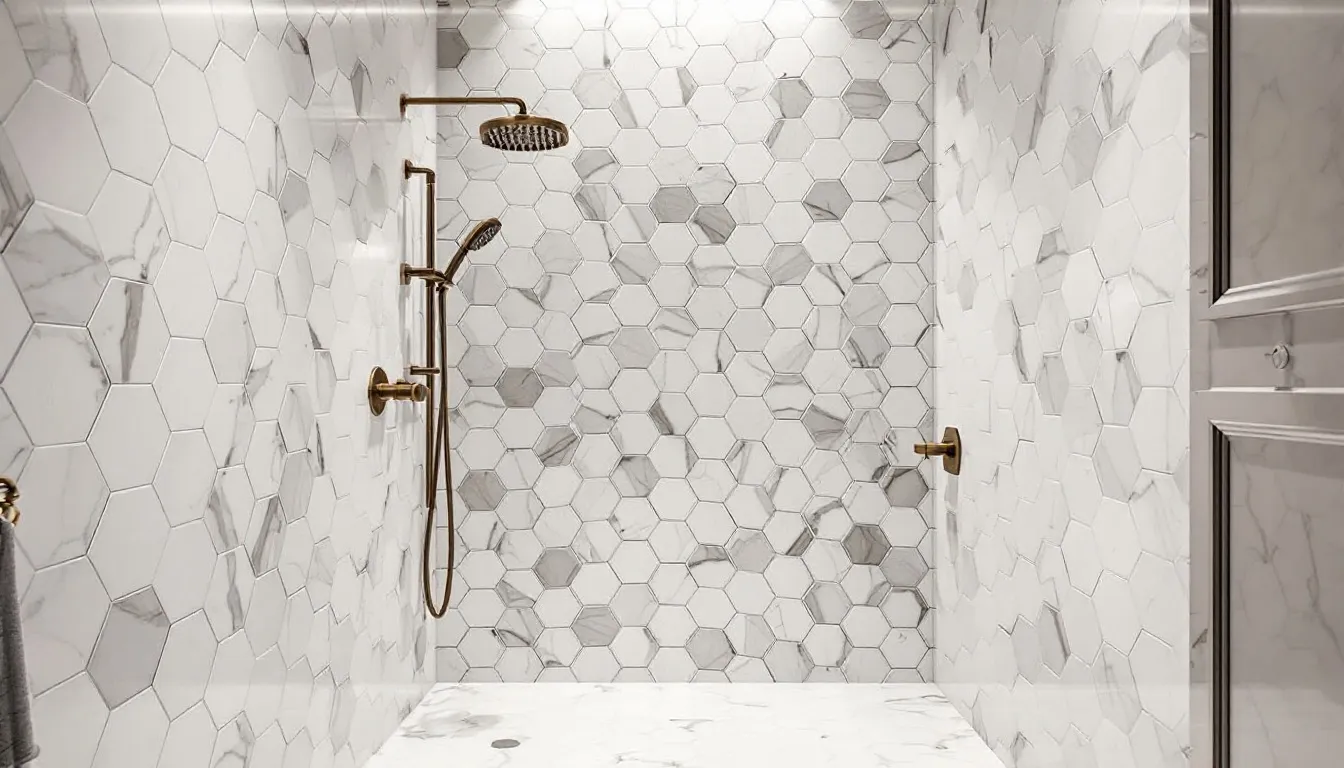
Small Bathroom Walk-In Shower Solutions
Corner Shower Installations to Maximize Space
Corner showers make efficient use of awkward bathroom layouts by fitting into spaces that might otherwise be unusable. These installations typically feature angled or curved glass enclosures that provide generous shower space while leaving the rest of the bathroom open for other fixtures.
Neo-angle corner showers with three glass panels and an angled entry work particularly well in tight spaces, providing access without requiring door swing clearance. The angled design also creates interesting visual geometry that can make small bathrooms feel more dynamic.
Glass Enclosures for Light Reflection
Glass shower enclosures are essential for making small bathrooms feel larger by allowing light to flow freely throughout the space. Clear glass panels reflect both natural and artificial light, creating the illusion of expanded square footage while maintaining visual connection between different areas of the room.
Frameless glass enclosures work best for this effect, as they eliminate visual barriers that might make spaces feel chopped up. Even frosted glass provides better light transmission than solid walls while offering additional privacy.
Curbless Entries for Visual Continuity
Curbless or zero-threshold entries eliminate the visual barrier created by traditional shower curbs, allowing the bathroom floor to flow seamlessly into the shower area. This creates an uninterrupted sight line that makes small bathrooms feel significantly larger.
Achieving proper drainage in curbless designs requires careful planning and skilled installation, but the visual payoff makes the extra effort worthwhile. The shower floor must be properly sloped to direct water toward the drain while maintaining level access for safety and accessibility.
Vertical Subway Tile Patterns for Height
Installing subway tiles in vertical patterns rather than traditional horizontal orientations draws the eye upward, making shower walls appear taller and small bathrooms feel more spacious. This simple trick costs nothing extra but creates significant visual impact.
Vertical patterns work particularly well in showers with low ceilings, where the upward emphasis helps counteract the compressed feeling that horizontal patterns might create. Pairing vertical wall tiles with horizontally oriented vanity backsplashes creates pleasing contrast throughout the bathroom.
Built-In Niches for Storage Without Floor Space
Recessed storage niches eliminate the need for corner caddies or hanging organizers that can make small showers feel cluttered. These built-in storage solutions are carved into the wall structure during construction, creating seamless storage that doesn’t sacrifice any floor space.
Multiple niches at different heights accommodate various toiletries while keeping everything organized and easily accessible. Tiling niches to match the surrounding walls maintains visual continuity while providing practical storage solutions.
Light-Colored Tiles and Fixtures for Brightness
Light colors reflect more light than dark alternatives, making them essential for brightening small bathroom spaces. White tile, cream natural stone, and light gray porcelain all help maximize the impact of available light while creating fresh, clean appearances.
Pairing light-colored tiles with bright chrome or polished nickel fixtures creates additional reflective surfaces that amplify light throughout the space. Even small touches like light-colored grout can contribute to the overall brightness of the room.
Luxury Walk-In Shower Features
Multiple Showerhead Systems for Spa Experience
Luxury walk in showers often feature multiple showerhead configurations that create personalized spa experiences. A typical luxury installation might include a large rainfall showerhead mounted in the ceiling, wall-mounted body jets for targeted massage, and a handheld showerhead for versatility.
Thermostatic controls allow precise temperature management across all outlets, ensuring consistent comfort regardless of which fixtures are in use. Some systems include pre-programmed settings that remember individual preferences for temperature and spray patterns.
Built-In Marble or Stone Benches
Natural stone benches provide both functional seating and luxurious material expression in high-end walk in showers. A shower bench made from materials like Carrara marble, black granite, or quartzite not only offers a comfortable place to sit but also serves as a practical storage area for toiletries or towels, enhancing both the luxury and practicality of the shower. Carrara marble benches create classic elegance, while more dramatic options like black granite or quartzite provide contemporary sophistication.
Built-in benches can incorporate hidden storage compartments for toiletries or towels, maximizing functionality while maintaining clean aesthetic lines. Heating elements beneath stone benches provide additional comfort during cold weather.
Heated Towel Racks and Radiant Floor Heating
Radiant floor heating transforms the shower experience by warming both the shower floor and the surrounding bathroom space. This luxury feature is particularly appreciated in doorless shower designs, where maintaining warmth can be challenging during colder months.
Heated towel racks positioned near the shower provide warm, dry towels after each use while helping to manage humidity in the bathroom. These fixtures are available in various styles and finishes to match other bathroom hardware.
Steam Room Capabilities
Steam shower capabilities transform ordinary walk in showers into private spa retreats. These systems require completely enclosed shower spaces with specialized steam generators and proper ventilation to manage moisture effectively.
Steam features work best in larger shower enclosures where users can comfortably sit on built-in benches while enjoying the therapeutic benefits. Proper waterproofing is essential, as steam creates more moisture than traditional showers.
Natural Lighting Through Skylights
Skylights provide dramatic natural lighting that transforms shower experiences throughout the day. Positioning skylights directly over shower areas creates beautiful effects as natural light filters through water and steam.
Privacy concerns can be addressed through frosted skylight glazing or strategic positioning that prevents sight lines from neighboring properties. Automated blinds or shades provide additional control over light levels and privacy.
Premium Materials Like Carrara Marble
High-end materials like Carrara marble, travertine, and premium porcelain create luxurious environments that rival high-end spas. These materials often feature beautiful natural veining and color variation that adds character to shower spaces.
While premium materials require higher initial investment, they provide lasting beauty and contribute significantly to home resale value. Proper sealing and maintenance ensure these materials maintain their appearance for decades.
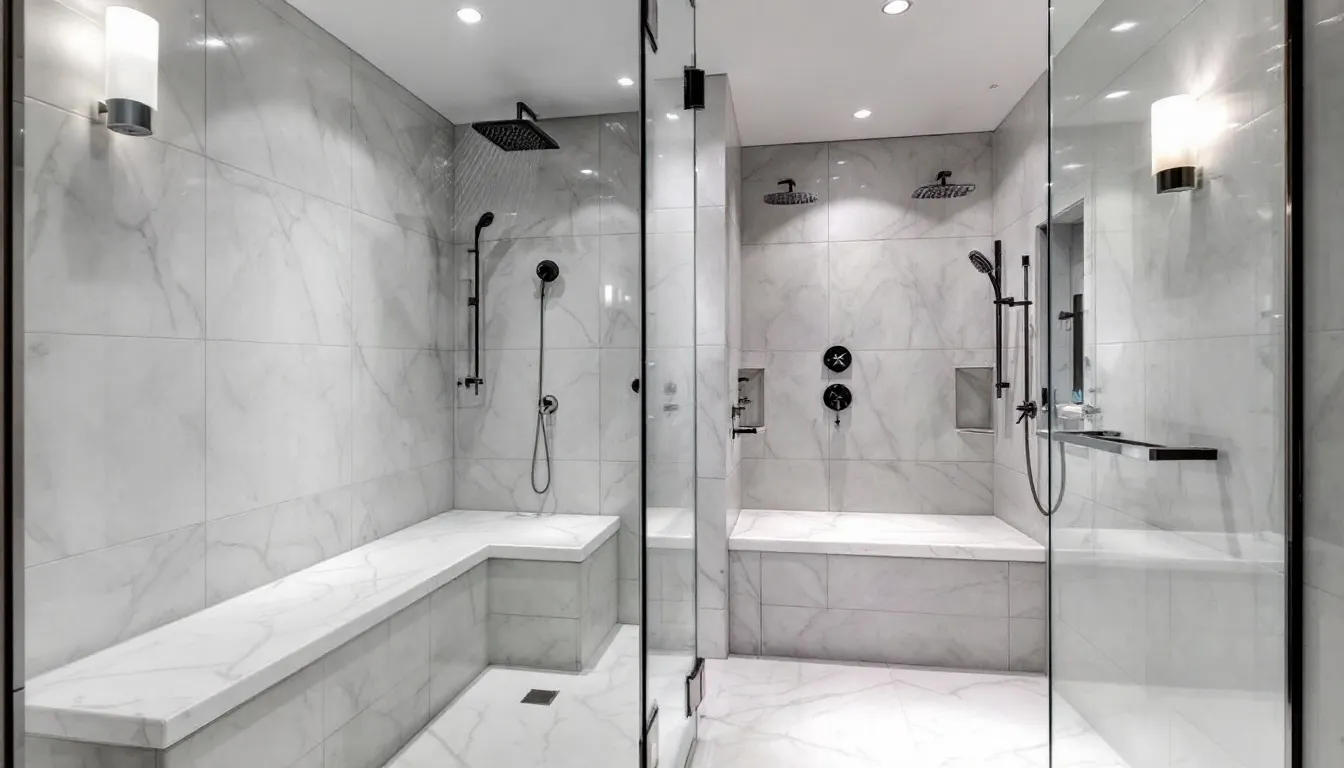
Walk-In Shower Storage and Organization
Recessed Wall Niches for Seamless Storage
Recessed niches built into shower walls provide storage that doesn’t protrude into the shower space or disrupt clean design lines. These storage solutions are integrated during the framing stage, creating perfectly sized compartments for shampoo, soap, and other toiletries.
Multiple niches at different heights accommodate various container sizes while keeping frequently used items within easy reach. Tiling niches to match surrounding walls maintains visual continuity throughout the shower space.
Built-In Corner Shelves
Corner shelves utilize often-wasted corner space for practical storage while maintaining the open feeling that makes walk in showers appealing. These shelves can be built from the same materials as shower walls or contrasting materials that add visual interest.
Angled corner shelves work particularly well in neo-angle shower designs, following the geometry of the space while providing multiple storage levels. Proper drainage details ensure that water doesn’t pool on shelf surfaces.
Floating Shower Benches with Hidden Storage
Floating benches appear to hover against shower walls while concealing storage compartments beneath their seats. These sophisticated storage solutions provide seating for shaving or relaxation while hiding toiletries and accessories.
The hidden storage compartments can be accessed through hinged tops or sliding panels, keeping contents dry and organized. Proper waterproofing around moveable components ensures long-term functionality.
Don’t forget the value of hidden storage in maintaining a clutter-free shower space.
External Towel Storage and Hooks
Positioning towel storage outside the direct water spray zone keeps linens dry while maintaining convenient access. Wall-mounted towel hooks, heated towel bars, and floating shelves can be strategically placed near shower entries for optimal convenience.
Multiple hook positions accommodate different user heights and preferences while ensuring that fresh towels are always within easy reach. Consider both function and aesthetics when selecting hook styles and finishes.
Drawer Storage Under Shower Benches
Built-in bench designs can incorporate drawer storage beneath seating areas, providing concealed storage for larger items like extra towels, cleaning supplies, or seasonal accessories. These storage solutions work particularly well in larger luxury showers where bench sizes allow for meaningful storage capacity.
Soft-close drawer hardware ensures quiet operation while water-resistant materials and finishes protect stored items from moisture. Proper ventilation prevents moisture buildup within storage compartments.
Glass Options and Door Styles
Frameless Glass Doors for Modern Appeal
Frameless glass doors create seamless, contemporary appearances by eliminating visible metal frames around glass panels. These doors rely on heavy-duty hinges and precise installation to function properly while providing crystal-clear views of beautiful tile work and fixtures.
The absence of frames makes cleaning easier since there are fewer crevices where soap scum and water spots can accumulate. Frameless doors work particularly well with minimalist design themes where clean lines are paramount.
Sliding Glass Doors for Space Efficiency
Sliding glass doors eliminate the space requirements associated with hinged doors, making them ideal for narrow bathrooms where door swing might interfere with other fixtures. These space-saving solutions can be just as elegant as hinged alternatives when properly designed and installed.
Track systems can be nearly invisible when integrated into ceiling or floor details, maintaining clean appearances while providing smooth operation. High-quality sliding hardware ensures years of reliable function.
Pivot Doors with Statement Hardware
Pivot doors create dramatic entries through the use of specialized hardware that allows doors to rotate on central pivot points rather than traditional side hinges. This configuration enables wider door openings and creates opportunities for striking hardware statements.
Oversized handles in brass, matte black, or brushed nickel finishes become focal points that complement other bathroom fixtures. Pivot doors work particularly well in luxury installations where hardware serves as jewelry for the space.
Fixed Glass Panels for Doorless Designs
Fixed glass panels provide water containment in doorless shower designs without completely enclosing the shower space. These panels are permanently mounted and don’t require hardware for operation, creating clean, maintenance-free barriers.
Strategic positioning of fixed panels directs water spray while maintaining the open feeling that makes doorless showers appealing. The panels can extend floor-to-ceiling or stop at convenient heights depending on specific design goals.
Frosted or Textured Glass for Privacy
Frosted glass options provide privacy without completely blocking light transmission, making them ideal for showers positioned near windows or in open bathroom layouts. Various texturing options create different levels of opacity while adding visual interest.
Rain glass, reed glass, and other textured options diffuse light beautifully while obscuring details for privacy. These glass types work particularly well in traditional bathroom designs where subtle pattern adds character.
Floor-to-Ceiling Glass Walls
Floor-to-ceiling glass installations create dramatic, spa-like environments by maximizing transparency and light flow. These installations require structural consideration since larger glass panels need substantial support systems.
The uninterrupted glass surfaces showcase beautiful tile work while creating impressive scale in luxury bathroom installations. Proper ventilation becomes even more important with large glass surfaces that can fog easily.
Color Schemes and Design Themes
Monochromatic White Schemes with Texture Variation
White color schemes remain timelessly popular for their ability to create fresh, clean environments that feel both spacious and serene. The key to successful monochromatic white designs lies in varying textures rather than colors to create visual interest.
Combining glossy white subway tiles with matte white hexagons, for example, creates subtle contrast while maintaining color consistency. White marble with dramatic gray veining adds natural pattern that prevents all-white schemes from feeling flat or sterile.
Bold Black and White Patterns
Black and white combinations create striking contrast that works well in both traditional and contemporary bathroom designs. Geometric patterns using these colors can make strong design statements while remaining timelessly elegant.
Checkerboard patterns, bold stripes, or mixed tile sizes in black and white create dynamic focal points without relying on temporary color trends. These high-contrast schemes work particularly well in smaller bathrooms where bold patterns can actually make spaces feel larger.
Warm Neutral Palettes with Natural Materials
Warm hues like beige, cream, and tan create welcoming environments that feel spa-like and relaxing. These colors work beautifully with natural stone materials that provide inherent warmth and organic pattern variation.
Travertine, limestone, and warm-toned marbles provide natural color variation within neutral palettes while adding texture and depth. These schemes create timeless appeal that won’t feel dated as design trends evolve.
Cool Gray Schemes in Multiple Shades
Gray color schemes offer sophisticated alternatives to pure white while maintaining neutral versatility. Using multiple shades of gray creates depth and interest while working with virtually any accent colors or materials.
Light gray shower walls paired with darker gray floors create subtle contrast while maintaining overall cohesion. Charcoal accents through fixtures or hardware add definition without overwhelming neutral schemes.
Navy Blue and White for Classic Appeal
Navy blue and white combinations create classic, timeless appeal reminiscent of traditional maritime themes. This color combination works particularly well in coastal or traditional bathroom designs where crisp contrast feels appropriate.
Navy blue accent tiles against white backgrounds create sophisticated focal points while maintaining enough contrast for visual interest. These colors pair beautifully with brass fixtures and natural wood vanity elements.
Earth Tone Designs with Natural Elements
Earth tone color schemes incorporating browns, rusts, and natural stone colors create warm, grounding environments that feel connected to natural elements. These colors work particularly well with textured materials and natural stone selections.
Terra cotta tiles, warm gray stones, and rich brown accents create layered, sophisticated environments that feel both contemporary and timeless. These schemes work beautifully with oil-rubbed bronze or warm brass fixtures.
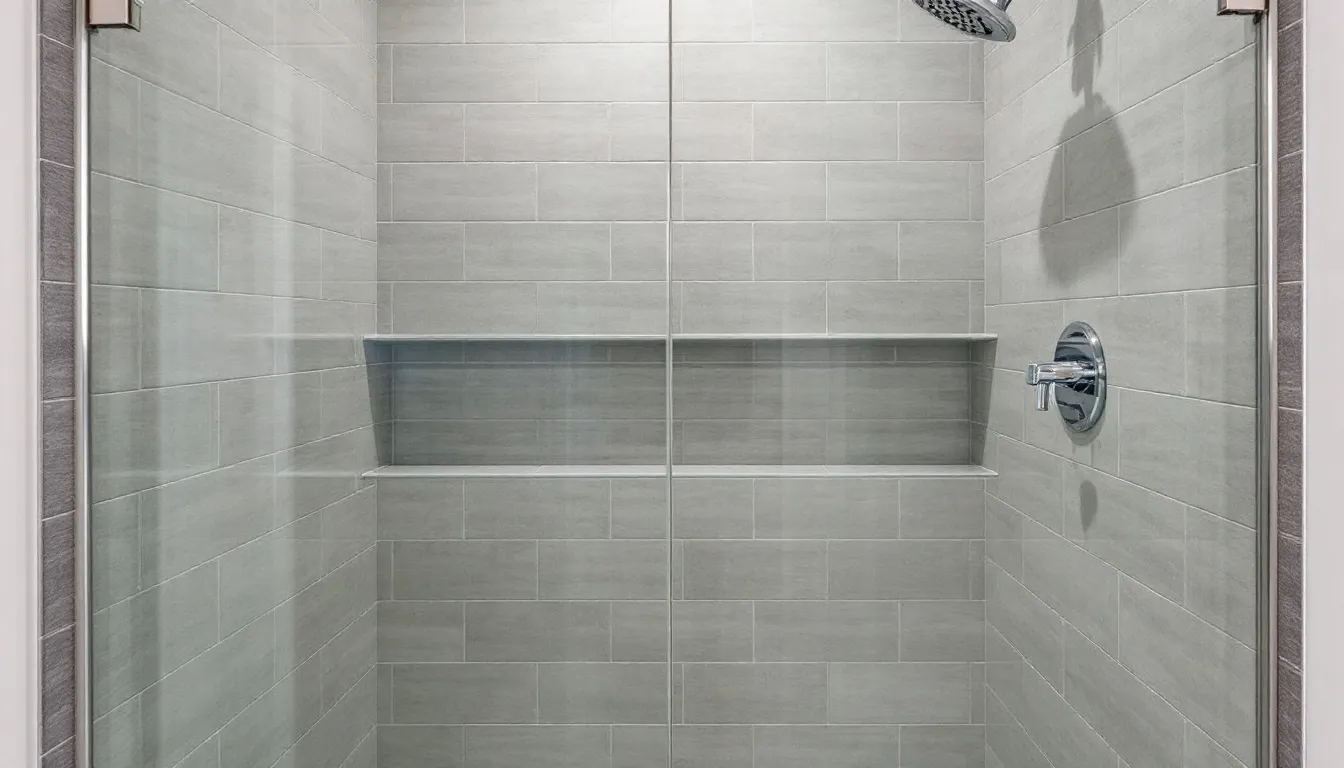
Walk-In Shower Lighting Solutions
Skylights for Natural Overhead Lighting
Skylights provide dramatic natural lighting that changes throughout the day, creating dynamic shower experiences that connect users with outdoor conditions. Positioning skylights directly over shower areas maximizes the impact of natural light while providing privacy.
Tubular skylights work well in situations where traditional skylights aren’t structurally feasible, bringing natural light through small roof penetrations. These solutions work particularly well in smaller bathrooms where every bit of natural light makes a significant difference.
Recessed LED Lighting Outside Spray Zones
Recessed LED lighting positioned outside direct water spray areas provides reliable illumination without moisture concerns. These fixtures can be dimmed to create different moods while providing adequate light for safety and grooming tasks.
Placing recessed lights in shower ceilings just outside the spray zone provides even illumination without creating water infiltration risks. LED technology ensures long life and energy efficiency while producing excellent light quality.
High Windows with Frosted Glass
High-positioned windows provide natural light while maintaining privacy from neighboring properties. Frosted glass ensures privacy while still allowing beneficial natural light to fill shower spaces.
Clerestory windows positioned above eye level provide light without compromising privacy, working particularly well in urban settings where neighboring buildings are close. These windows can often be operable to provide natural ventilation.
Decorative Pendant Lights in Enclosed Rooms
In fully enclosed shower rooms or wet rooms, decorative pendant lights can create dramatic focal points while providing task lighting. These fixtures must be rated for wet locations and positioned appropriately for safety.
Pendant lights work particularly well in larger shower spaces where their scale can be appreciated. Proper positioning ensures they don’t interfere with shower use while providing beautiful ambient lighting.
Strip Lighting Behind Mirrors or in Coves
Hidden strip lighting creates ambient illumination that enhances the overall atmosphere without creating harsh shadows. LED strip lights behind mirrors or in ceiling coves provide gentle, even lighting that flatters users.
Color-changing LED strips allow customization of lighting moods, from energizing cool white for morning routines to relaxing warm white for evening baths. These systems can often be controlled through smartphone apps for ultimate convenience.
Motion-Sensor Lighting for Convenience
Motion-sensor lighting provides automatic illumination when entering shower areas, eliminating the need to fumble for switches with wet hands. These systems can be programmed to provide different light levels for different times of day.
Battery-powered motion sensors work well for retrofit situations where running new electrical circuits might be challenging. These sensors can trigger both primary lighting and accent lighting for complete automation.
Accessibility and Safety Features
Curbless Entries for Universal Access
Curbless entries eliminate barriers that can be challenging for wheelchair users or individuals with mobility limitations. These entries require careful planning to ensure proper drainage while maintaining level access from the bathroom floor to the shower floor.
Achieving proper drainage in curbless designs often requires lowering the shower area slightly and using linear drains positioned strategically to collect water effectively. The visual benefit of seamless transitions makes this extra planning effort worthwhile even for users without mobility limitations.
Grab Bars Integrated into Tile Design
Modern grab bars can be integrated seamlessly into tile designs rather than appearing as afterthoughts. These safety features are available in decorative finishes and configurations that complement bathroom aesthetics while providing essential support.
Positioning grab bars during the design phase ensures that proper backing is installed within walls to support weight requirements. Strategic placement provides support for entering, exiting, and maneuvering within shower spaces.
Non-Slip Floor Tiles for Safety
Textured or slip-resistant tiles are essential for shower floor safety, particularly in doorless designs where water might spread beyond traditional shower boundaries. Modern slip-resistant tiles are available in beautiful designs that don’t sacrifice aesthetics for safety.
Natural stone tiles with tumbled or textured finishes provide excellent slip resistance while maintaining sophisticated appearances. Smaller tiles with more grout lines also provide additional texture for improved traction.
Fold-Down Shower Seats
Fold-down seats provide temporary seating that doesn’t permanently consume shower space when not needed. These seats are particularly valuable for elderly users or those recovering from injuries who need occasional seating support.
Modern fold-down seats are available in attractive materials and finishes that complement shower designs while providing reliable support when needed. Proper installation with adequate backing ensures safe operation.
Lever-Style Controls at Accessible Heights
Lever-style controls are easier to operate than traditional knob-style fixtures, particularly for users with arthritis or limited hand strength. Positioning these controls at accessible heights ensures they can be reached safely from both standing and seated positions.
Thermostatic controls provide additional safety by preventing temperature fluctuations that could cause scalding. These controls maintain consistent water temperature even when water pressure changes elsewhere in the house.
Wide Doorway Openings for Universal Design
Doorway openings of at least 32 inches accommodate wheelchairs and other mobility devices while providing generous access for all users. Wider openings create more gracious entries that feel welcoming rather than cramped.
Eliminating traditional thresholds in favor of flush transitions ensures smooth access for mobility devices while creating seamless visual flow between bathroom areas. These design decisions benefit all users regardless of mobility status.
Budget-Friendly Walk-In Shower Ideas
Prefabricated Fiberglass Units with Built-In Features
Prefabricated shower units offer affordable solutions that include built-in seating, storage ledges, and soap dishes without requiring custom construction. Choosing a prefabricated unit can significantly reduce the overall cost of a walk-in shower compared to custom installations. These units are available in various sizes and configurations to fit most bathroom layouts.
Modern prefabricated units feature attractive textures and colors that rival custom installations while providing faster installation and lower costs. Some units include accessibility features like grab bar mounting points and low thresholds.
Standard Ceramic Subway Tiles
Standard ceramic subway tiles provide classic appeal at affordable prices while offering versatility in pattern and layout options. These tiles are readily available in various colors and finishes, making them accessible for most budgets.
Installing subway tiles in interesting patterns like herringbone or vertical orientations creates custom appearances without premium material costs. The key to successful budget installations lies in selecting quality installation materials and skilled labor.
Chrome Fixtures Instead of Specialty Finishes
Chrome fixtures and hardware provide attractive, durable finishes at lower costs than specialty options like brushed gold or matte black. Chrome’s reflective properties also help brighten shower spaces while requiring minimal maintenance.
Coordinating all fixtures and hardware in matching chrome finishes creates cohesive appearances that look intentional and well-designed. This approach often looks more sophisticated than mixing multiple finish types randomly.
Single Showerhead Installations
Single showerhead installations focus budget on quality components rather than multiple fixtures, often resulting in better overall performance and appearance. High-quality single showerheads can provide excellent water pressure and spray patterns.
Choosing showerheads with multiple spray settings provides versatility without requiring multiple fixtures. Wall-mounted installations are typically more affordable than ceiling-mounted rainfall systems while still providing satisfying shower experiences.
Basic Glass Doors Instead of Custom Frameless
Standard framed glass doors provide enclosure and water containment at significantly lower costs than custom frameless installations. Modern standard doors are available in attractive finishes and configurations that work well with most design themes.
Semi-frameless options provide compromise solutions that offer some of the appeal of frameless doors while maintaining more affordable price points. Proper installation ensures these doors function reliably for years.
DIY Tile Installation with Professional Waterproofing
Homeowners with appropriate skills can save significantly by installing tiles themselves while hiring professionals for critical waterproofing work. This approach ensures proper moisture protection while reducing labor costs for visible work.
Proper surface preparation and waterproofing are essential for long-term success, making professional installation of these components a worthwhile investment. DIY installation works best for straightforward patterns and standard tile sizes.
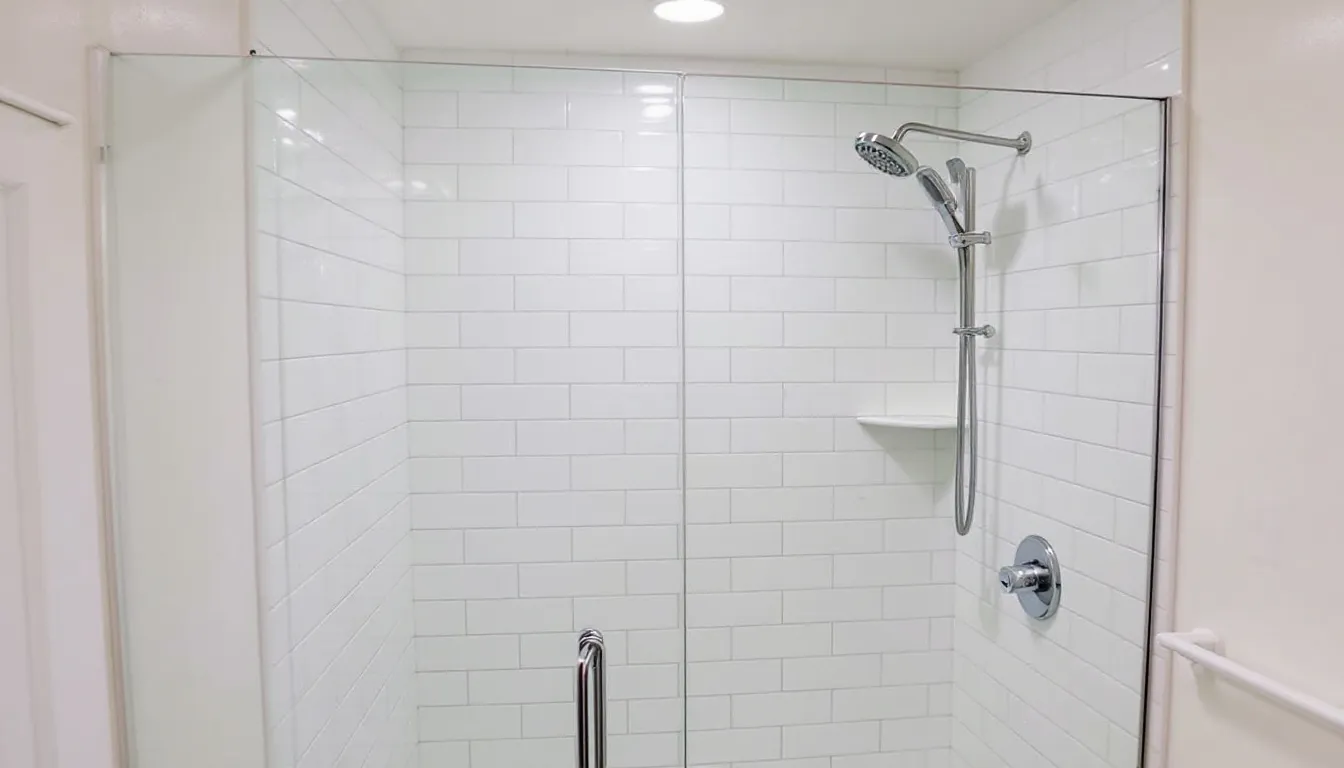
Installation Considerations and Planning
Waterproofing Requirements for Long-Term Success
Proper waterproofing forms the foundation of any successful walk in shower installation, requiring waterproof membranes behind all tile surfaces and specialized waterproof systems around penetrations. This invisible work prevents costly water damage and ensures long-term performance.
Cement board provides a stable substrate for tile installation while specialized membrane systems create complete moisture barriers. Professional installation of these systems is essential since mistakes can lead to expensive repairs down the road.
Plumbing Relocations and Valve Positioning
Moving plumbing lines to accommodate new shower layouts often represents a significant portion of renovation costs but may be necessary to achieve optimal functionality. Shower valves should be positioned for convenient access while maintaining proper clearances from other fixtures.
Planning valve positions during the design phase prevents costly changes during construction while ensuring that controls are accessible and properly protected from water spray. Multiple outlet systems require careful planning to ensure adequate water pressure.
Working with a designer can help ensure your walk-in shower renovation achieves an optimal plumbing layout and a functional, well-designed space.
Ventilation Requirements for Moisture Management
Adequate ventilation prevents moisture buildup that can lead to mold, mildew, and structural damage. Walk in showers, particularly doorless designs, require more ventilation than traditional enclosed showers due to increased moisture dispersion.
Exhaust fans should be sized appropriately for the bathroom volume and positioned to effectively remove moisture without creating uncomfortable drafts. Some installations benefit from multiple exhaust points or fans with humidity sensors for automatic operation.
Structural Considerations for Heavy Materials
Natural stone tiles and thick concrete shower pans add considerable weight that may require structural reinforcement, particularly in upper-floor installations. Proper evaluation of existing floor systems prevents problems during and after installation.
Large format tiles and stone slabs may require additional support during installation to prevent cracking or movement. Professional evaluation ensures that structural systems can support planned materials and fixtures safely.
Permit Requirements and Code Compliance
Major bathroom renovations typically require building permits to ensure compliance with local building codes and safety requirements. Permit requirements vary by location but often include plumbing, electrical, and structural work.
Working with licensed contractors helps ensure permit compliance while protecting homeowners from liability issues. Some jurisdictions allow homeowner permits for specific types of work, but professional consultation is usually beneficial.
Timeline Expectations for Different Complexity Levels
Simple shower replacements using prefabricated units can often be completed in 3-5 days, while complex custom installations with natural stone and multiple fixtures may require 2-3 weeks. Understanding realistic timelines helps homeowners plan accordingly.
Factors affecting timelines include material availability, complexity of waterproofing requirements, plumbing modifications, and drying time for various installation materials. Weather can also affect timelines for projects requiring exterior work or ventilation.
Conclusion
Walk in shower ideas offer endless possibilities for creating beautiful, functional bathrooms that enhance daily routines while adding significant value to homes. Whether you’re working with a compact bathroom that needs clever space-saving solutions or designing a luxury master bathroom with premium materials and spa-like amenities, the right walk in shower design can transform your space.
The key to successful walk in shower planning lies in balancing your aesthetic preferences with practical considerations like budget, accessibility needs, and maintenance requirements. From affordable subway tile installations to luxurious marble designs with multiple showerheads, there’s a walk in shower solution for every situation.
Remember that proper waterproofing, ventilation, and professional installation form the foundation of any successful shower project. While DIY approaches can work for some elements, investing in professional expertise for critical components ensures long-term satisfaction and protects your investment.
As you explore these walk in shower ideas, consider how each option aligns with your specific needs, lifestyle, and long-term plans for your home. Whether you prioritize accessibility features, storage solutions, or luxury amenities, the perfect walk in shower design is waiting to transform your daily routine into a spa-like experience you’ll enjoy for years to come.
